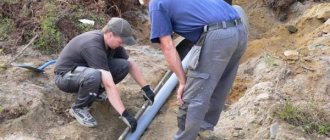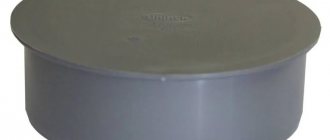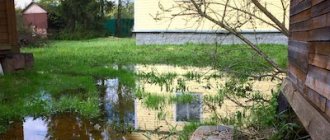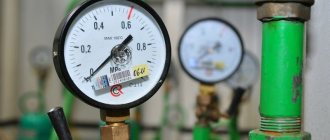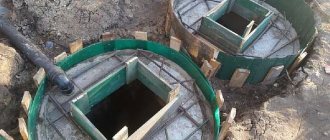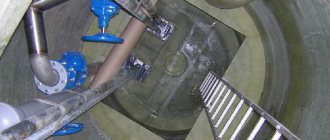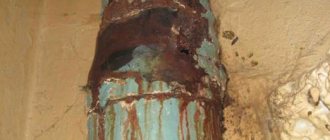- Basis for budgeting
- Procedure for compilation
- Filling Features
An estimate for external sewerage is a document that describes in detail the necessary work, indicating all operations and the amount of materials required.
Such a calculation can be made for individual types of work during repair or construction, or can be part of a resource estimate calculation when constructing a complex building from scratch.
Sewerage estimates.
When drawing up estimates for sewerage, it is important to take into account many factors, relying on the design documentation of the facility, as well as current building codes and regulations. Also, often, in addition to drawing up estimates using prices for sewerage work, it is necessary to simultaneously submit an estimate for replacing water supply pipes or an estimate with prices for installing storm sewers. This is usually due to the fact that sewerage work, storm sewer installation work, and the laying of water supply pipelines and heating networks are most often carried out simultaneously while excavation work is underway and all the trenches have not yet been filled up. Sometimes a general estimate for water supply and sewerage is even provided, because often the water supply and sewerage routes are not only laid at the same time, but also have points of contact when installing communications.
Sample estimate for water supply and sewerage.
To understand how to draw up an estimate for laying water supply and sewerage systems, which collections of FER standards to take prices from, and what to use as a guide when choosing a price, we provide a sample estimate for external water supply and sewerage networks, as well as for internal communications (Figure 1). It should be noted that the estimate in Figure 1 was created for demonstration purposes only, therefore all technical parameters, as well as the scope of work, were applied spontaneously. When drawing up an estimate for water supply, an estimate for installing sewerage inside buildings or for any other part of sewerage work, it is necessary to strictly follow the design requirements. Below we will consider in more detail the sample estimate in Figure 1, divided into prices for the installation of both external and internal water supply and sewerage networks.
Figure 1. Sample estimate for water supply and sewerage
Additional expenses
Sewerage, like other communications, must be depicted on plans. To do this, any change or installation must be legalized. Sometimes this may require you to pay fees or involve specialists who will help you arrange everything correctly.
If you need to draw up an estimate that takes into account the entire cost of laying a sewer system, then this should also be included as a separate expense item. If only the costs of the work themselves are provided, then this is not taken into account.
Estimate for water supply. External networks.
So, as can be seen in Figure 1, the estimate for cold water supply is reflected in section No. 1. It should be noted that all prices in the estimate for laying water supply pipes, both hot and cold, during new construction are most often used in local estimates, estimates in form No. 4, KS-2 and in other estimate documentation, based on collections of 22 estimates FER standards (or GESN, if estimate forms must be compiled using the resource method). The collection FER 22 is called “Water supply - external networks” and takes into account a whole range of prices for laying water supply networks outside buildings and structures, namely: laying pipelines, anti-corrosion treatment of pipelines, installing water fittings, installing wells, laying pipes using the trenchless method and others work. It is also important to note that work on excavation of soil, preparation of trenches and other earthworks are not included in the FER22 collection and must be assessed separately in accordance with the FER01 “Earthworks” collection.
Thus, in the estimate in Figure 1, the price from the FER22 collection under the code FER22-01-021-01 is used, sounding like “Laying pipelines from polyethylene pipes with a diameter of 50 mm.” As you can see, the choice of standard number in the FER22-01-01 tables should be justified by the diameter of the pipes. Tables FER22-01-021 take into account the scope of work for laying polyethylene pipes with diameters from 50 mm to 1600 mm inclusive. The work price used in Figure 1 includes: trimming the ends of pipes, welding pipes into a string, lowering the strings into a trench, hydraulic testing of the pipeline and adding approximately 10 cm of soil.
In addition, the collection of 22 estimated standards FER/GESN takes into account the work of laying pipelines not only from polyethylene pipes, but also from pipes of other compositions, for example, cast iron, steel, reinforced concrete, etc.
Special cases
Drawing up an estimate is possible only after a complete inspection of the facility, analysis of the site, and collection of all information regarding the purpose of the system. Instead of complete construction, other types of work may be required:
- cleaning The processing method, tools or special equipment are indicated;
- repair. Work with pressure systems becomes the most labor-intensive. An example would be an estimate for an industrial storm sewer metering unit, which requires installation and adjustment of waste liquid flow meters;
- replacement of individual components or an entire section of the system.
There are other works that need to be calculated and costs assessed. The more accurate and detailed the estimate is, the more effective the actions will be and the faster the process will be completed.
Estimate for water supply. Internal networks.
The second item in the estimate for cold water supply, as shown in Figure 1, is the price in the estimate for laying polypropylene water supply pipes under the code FER16-04-005-01. Estimates for water supply from polypropylene pipes are most often prepared for internal water supply networks. Internal water supply, sewerage and heating networks are combined into one collection in the FER estimate standards called “Internal Pipelines”. This is also justified by the fact that heating, sewerage and water supply networks are often laid not only simultaneously, but also from similar materials and using similar methods. Also, often with the simultaneous construction of communications, it becomes necessary to apply prices in the estimate for the laying of ventilation ducts.
In addition to laying direct pipelines inside premises and buildings, the standards of the FER16 collection also take into account the installation of pipeline fittings, arrangement of units, installation of meters and hydraulic testing of finished networks.
Types of external systems
There are drainage networks with different designs, tasks performed, and other parameters. Among them are:
- pressure or gravity systems. The first ones consist of pumping equipment and require special pipelines and connections. However, the second, non-pressure networks are in the lead;
- domestic, industrial, stormwater systems. Industrial storm networks are considered a separate type. They represent a compromise between rainwater and industrial drainage systems;
- public or private lines. The former supply wastewater to treatment facilities, the latter themselves clarify the liquids and release conditionally clean water into a reservoir or other discharge point.
Estimates for storm drainage are based on a design that takes into account local weather or climatic conditions.
Also read: Gray or orange sewer pipe: what’s the difference or which pipes are better
Estimate for external sewerage.
If you need to draw up an estimate for external sewerage, you should refer to the prices of collection 23 “Sewerage - external networks” of the regulatory frameworks of the FER and GESN. This collection includes a full range of prices for the installation of sewerage pipelines. For example, in addition to the prices in the estimate for laying sewer pipes, it is possible to select a price for the installation of sewer wells. Also, the estimate for the installation of external sewerage can take into account the work of installing hatches, installing filter bases and much more.
In Figure 1, in section 2 of the estimate for external sewerage, the price code FER23-01-020-01 is applied, sounding like “Laying sewer free-flow socket pipes made of polyvinyl chloride (PVC) with a diameter of 250 mm.” This price, like the main part of the price for laying all other types of pipelines, is selected depending on the diameter of the pipes. The quotation under the code FER23-01-020-01 includes in the scope of its work, in addition to the actual laying of the external sewerage pipeline, work on aligning pipes in the trench, installation of rubber rings and hydraulic testing of the finished pipeline. All prices relating to the installation of pipelines, both external and internal, as a rule, are calculated according to the standards of the FER/GESN bases in meters.
It should be noted that the prices in Book 23 are suitable for drawing up estimates for sewerage in a private house, as well as in industrial premises, multi-apartment residential buildings and offices.
In addition, sometimes it is necessary to include a price for the dismantling of sewer pipes in the estimate for sewerage. In this case, the choice of price should be justified depending on the type of construction. If dismantling occurs during the renovation of a facility, then it would be advisable to use the estimated norms of repair collections of the FER/GESN regulatory framework. If a price estimate is needed for the dismantling of sewer pipes during new construction or reconstruction, then the building codes provide for different coefficients for dismantling.
Features of some cases
Sometimes it may be necessary not to completely lay a sewer system, but only to perform certain work on an existing structure, because the sewer system requires further maintenance. In this case, the estimate will be drawn up with some reservations and nuances. The main special cases include:
- Sewer cleaning. In this case, the estimate will only need to include payment for the rental of equipment and hired workers. As a rule, if you engage a specialized company, then they already have everything they need and it will be enough to simply pay the specified amount. This requires special devices for cleaning and pumping out excess water. Payment is calculated in full for work performed, and not based on time spent.
- Repair. If something is broken in the sewer and repairs are required, then all costs in the estimate can only be indicated after an assessment of the situation. To begin with, the technician inspects the sewer, identifies the breakdown, and then draws up an estimate. It includes the costs of hired equipment (sometimes this may not be necessary if internal work is required), payment of workers and the purchase of the necessary materials. If everything can be repaired, then sometimes you don’t have to buy anything extra at all. The estimate will be completely different for each specific case. Costs can only be determined based on what kind of breakdown was discovered.
- Opening the sewer well chamber. If it is not possible to gain access to the sewer system through hatches or openings provided for this, then complete work will be required to open the well. To do this, you need to remove the road surface and then lay it again after all the work is completed. In this case, the estimate must include: the cost of special equipment for removing the coating, laying it, and opening the well itself. You also need to take into account the costs of transporting the remaining coating and paying workers. In this case, you will need to additionally take into account the costs of materials (new road surface, parts of sewer pipes).
- Replacement of sewerage. If a complete replacement of the sewer system is required, then the costs should include absolutely everything that is usually taken into account when laying a sewer system from scratch. Additionally, the costs of removing the road surface (if work is carried out outside, you need to use special equipment) and its transportation are taken into account. But you can save on arranging the trench itself, insulating it and digging.
- Cleaning and replacement of storm drains. Such sewerage is usually cleaned using equipment specially designed for this purpose. Payment includes the cost of fuel, which is required quite a lot in the process of cleaning and pumping out water. It may also be necessary to employ more workers if cleaning is done manually. To replace a storm sewer, you need to take into account the same costs as during its initial installation, without including in the cost only the digging of the trench itself and its strengthening. If this is also required for some reason, then the estimate is drawn up in the same way as laying a sewer system “from scratch.”
- Replacement of sewerage in an apartment building. If the sewer system in such a house is changed, then you need to take care of further repairs. If the sewerage system runs through the floors and needs to be completely replaced, then it will be necessary to provide for the costs of dismantling part of the wall and its further restoration, plastering, and painting. If there are appropriate wells, then it is only necessary to provide for payment of workers and the purchase of new pipes themselves. Next, the necessary repairs are calculated individually for each apartment.
- Technical specifications for estimates for sewerage design. If it is necessary to design a sewer system for a special industrial facility, then a task is first drawn up taking into account all the requirements, for which a competent specialist draws up a plan. In this case, the estimate only includes payment for his work, which is calculated in total, and not hourly, as for many workers.
Thus, it is possible to calculate the final amount of the estimate only when the object has been inspected and all the requirements for it have been determined.
Back…
Estimate for internal sewerage.
In Figure 1 in Section 2, prices from collection 16 are used, which can be used when drawing up estimates for internal sewerage, including. The price in the estimate for laying sewer pipes inside buildings can be selected from sections 1-4 of the collection 16 for internal pipelines. In Figure 1, in position No. 4, the price code FER16-04-001-01 is applied. The norms of this price, as the name suggests, take into account the work of laying internal sewerage from high-density polyethylene pipes. The choice of standard number depends on the diameter of the polyethylene pipe, which is taken into account by tables FER16-04-001 in the range from 50mm to 200mm inclusive. The work of tables FER16-04-001 includes not only the installation of the pipeline on fastenings, but also the installation of valves and testing work. The price in the estimate for installing a sewer plug may also be included in the pipeline laying work. This will depend on the material the pipeline and plug are made of.
For the installation of various internal devices, both sewerage and water supply, the FER/GESN estimate standards provide for collection 17. In this collection, entitled “Water supply and sewerage - internal devices”, it is possible to find both the price in the estimate for the installation of sewer drains and the price in the estimate for installation of a sewer inspection, as shown in Figure 1.
In cases where it becomes necessary to apply a price in the estimate for the installation of a sewer pump as part of the FER collections, a universal price is not provided. This may be due to the fact that sewage pumps differ in technical characteristics and installation technology. In this regard, the price in the estimate for the installation of a sewage pump can be selected from the prices of the installation collection FERm 07.
Reasons for drawing up
Before you start drawing up an estimate, you need to make a preliminary plan. The plan indicates the location of the sewer system if it needs to be laid from scratch. To draw up such a plan, an appropriate specialist is involved, whose payment is also included in the estimate.
In order to draw up a plan, the soil, structure and the premises itself are analyzed. Based on this, a decision is made on how the sewerage system will be located. The length of the pipes (and, accordingly, the costs for them), the quantity and standards of materials necessary for strengthening will depend on this. In the future, the individual wishes of the client are taken into account. This is especially true for interior work, when the aesthetic aspect is taken into account.
When drawing up the plan, approved state standards are also taken into account. There is a certain set of standards and technologies that are prohibited from being violated when carrying out such work.
The materials to be used can be agreed upon with the customer, that is, selected based on his personal preferences. But there is a certain rule: you can only use materials that are better than those specified in the standards. If the customer insists on purchasing materials that are worse in quality than those required by regulations, then it should be explained that such sewerage may not pass certification and legalizing it will be extremely problematic. This is especially important in cases where the customer is a government organization - here the requirements for compliance with all standards are more stringent.
